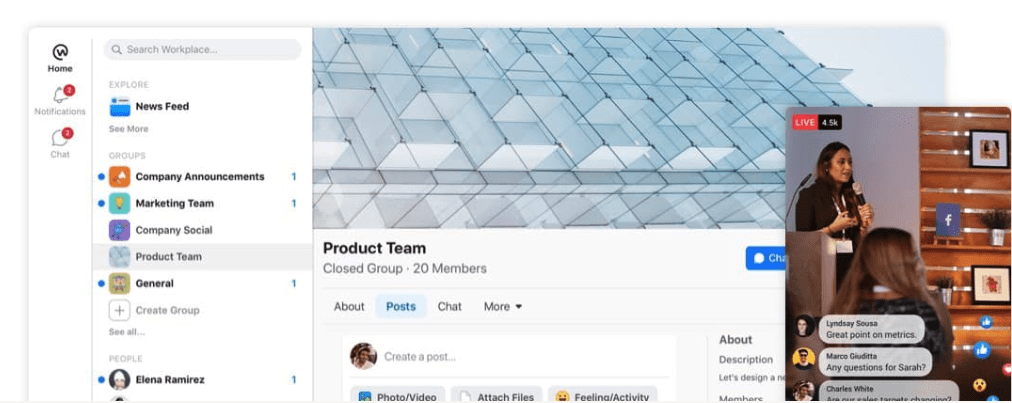In order for organizations to stay connected, productive, informed, and be able to collaborate more effectively — you’ll need to implement some communication tools.
Yet as the number of technologies and platforms grow, you have a massive amount of options to choose from and to use.
Below I’m going to share more about communications in this new decade, some statistics, and an overview of some top communications tools to consider.
Importance of Communications
While marketing and sales may get a lot of the glory within your organization, communications is the driving factor in business success.
It plays a role in your external efforts and internally with employees. After all, you want to ensure information is delivered and your entire organization is on the same page.
And you probably are familiar with most of the terminology used like external communications, internal communications, employee communications, workplace communications, etc.
Many variations to consider, but all contribute to delivering results.
While you probably have a good idea of what good communications does for your company, let’s recap here quickly.
- Increases knowledge sharing
- Improves employee engagement
- Keeps employees informed about their company
- Increase productivity among teams
- Makes internal collaboration easier
- Helps improve the work culture
- Ensures clearer and consistent messaging
- Drives the external conversations around the brand
- Increases feedback to improve processes and messages
- Improves customer experience
I’m sure you might even have a few more in mind than the above, but you get the big picture. And the challenge is, for large organizations with global offices, communications can become disorientating.
Communications Statistics
Before I move onto some of the best communication tools, I wanted to share some data. I always find that statistics and research can really show the need and value for particular strategies, tools, and processes.
And with communications that is no different. Take a look at a few interesting stats below.
- 60% of companies don’t have a long-term strategy for their internal communications. (Workforce)
- 86% of employees and executives cite lack of collaboration or ineffective communication for workplace failures. (Salesforce)
- 33% of employees said a lack of open, honest communication has the most negative impact on employee morale. (Recruiter)
- 85% of employees said they’re most motivated when management offers regular updates on company news. (Trade Press Services)
- More than 80% of Americans say employee communication is key to developing trust with their employers. (Lexicon)
- The Queens University survey found that there is significant support for the use of social tools for workplace collaboration. 31% of baby boomers, 40% of Gen X, and 49% of millennials support social tools for collaboration.
- When companies use social media internally, messages become content; a searchable record of knowledge can reduce, by as much as 35%, the time employees spend searching for company information. (McKinsey)
Top Communication Tools
Thanks to technology, we have access to some great products and software that enables organizations to be more organized and communicate effectively.
However, with that also comes a bevy of options that can sometimes be overwhelming. While you want to use technology to streamline communications, too much technology can also prove cumbersome.
Below are some of the top communication tools your organization might want to consider (if it hasn’t already).
Additionally, your goals and objectives for communications and collaboration may vary, so not every tool will be the perfect fit at your company per se.
1. Slack

By now, I think almost the entire world is familiar with Slack as it quickly became a huge brand name in the last few years. The idea behind Slack was simple, but it proved to be a powerful tool for internal communication and collaboration.
If you aren’t familiar with the communication tool, Slack allows people to subscribe to various channels that are important to their role, department, or company.
This makes communication a breeze and also keeps things organized according to user defined categories.
Slack is great for company-wide or department announcements, communicating with individuals separately, video calls, and more.
Plus the platform integrates with numerous apps and workflows to help monitor ticketing, sales, support, and more to ensure the appropriate people are notified and informed.
Many people have decried Slack’s claim to increasing productivity however, lamenting how the tool can inhibit deep work, constantly distracting employees with a cascade of irrelevant messages, GIFs and Likes.
As with any communication tool, how Slack is used depends on the size and culture of your organization.
2. Discord

Originally designed and marketed to gamers who previously relied on Skype or TeamSpeak to communicate while playing together, Discord is very similar to Slack and has seen surprising adoption amongst non-gamer communities.
Whether Discord will be adopted by startup, SMB or enterprise companies has yet to be seen however.
No doubt some startups are using Discord right now; I would not be surprised.
Very similar to Slack in terms of user experience, Discord is primarily a channel organized chat program, but instead of “workspaces” as found in Slack, Discord employs “servers” that house their respective user created channels and content.
Discord includes voice calling, video chat, screen sharing, and a mobile app.
3. Workplace By Facebook

A new platform on the scene in Workplace by Facebook. Since the social platform has billions of people on it, it made sense that they could make a collaboration tool for your organization to utilize.
Workplace allows your organization to share important info with your whole employee base. Mark info as “important” so you ensure everyone sees it.
Find out what employees think by running a poll. Or supplemental features like video chats, quick chats, not to mention all of this on a mobile version as well.
Just like Slack, this also has many integrations that will be useful for collaborating and communicating. Dropbox, G-Suite, Office 365, to name a few but they boast 50 enterprise integrations.
4. EveryoneSocial

It should come as no surprise that we would add our own platform! Although I may be a little biased, EveryoneSocial is a great solution for employee communications, knowledge sharing, and boosting employee engagement.
As the central hub for all employees, this is where organizations can share company news, content, third-party content, and get feedback from employees.
Essentially, EveryoneSocial helps your organization build a workplace community where employees can connect with others, engage with teammates, follow colleagues, and stay informed on the latest happenings. Of course, they can also share content and create content as well.
Features include email newsletter program options, push notifications, mobile apps, browser extensions to ensure your team is seeing the information and staying connected within the workplace — and numerous integrations too (Including Slack and Microsoft Teams).
Related: Learn how Cyxtera built a connected global workforce and improved internal communications by using employee advocacy platform EveryoneSocial. Read the interview and insights here.
5. Trello

Project management tools are also great for boosting communications and collaboration. I chose Trello in this one as I’ve used this tool fairly often over the years.
The project management tool is now owned by Atlassian, but is entirely free to use.
Trello uses boards, lists, and cards enable you to organize and prioritize your projects. This makes it easy for collaboration, staying organized, and communicating on various jobs or tasks.
The platform also boosts productivity by creating automation through teams to remove tedious tasks or simplify your to-do lists with you having to clean it all up.
Similarly to the other communication tools in this list, there are tons of integrations and options for mobile collaboration.
Trello is also one of many project management tools for boosting internal comms and collaboration. Others include Asana, Monday.com, Basecamp, Wrike, and many others.
6. Zoom

Videos are a big part of team collaboration, prospecting, and more. So I had to include Zoom as a top communication tool in this list.
At EveryoneSocial, we also use Zoom quite often, especially when we are working remotely.
If you have not used Zoom before, here are a few major components to their software.
Scheduling, chat/messaging, email invitations, live/video conferencing, meeting management, screen sharing, user management, reporting & statistics, company branding, video call recording, drag & drop file sharing, and synced content library.
As you can see, tons of options to stay connected to your teams, global teams, and with employees wherever they may be in the world.
7. G-Suite

And last, but not least on this list of top communication tools in Google’s G-Suite products. And not just one particular part to the G-Suite, but all their product options.
These products from Google allow teams to stay connected and collaborate on numerous items and work related projects.
For example Google Docs and Google Sheets are two powerful and simple products of the G-Suite that most organizations take advantage of internally.
So what sort of communications go into G-Suite? You probably are familiar with many but here are a few:
Email & chat archiving, auditing & reporting, custom email address, cloud file storage, mentions, customizable templates, file transfer, shared workspace, video conferencing, two-way audio & video, email tracking, instant messaging, resource allocation, to-do list, and email notifications.
Final Thoughts
There you have it! A list of communication tools that will help streamline information, collaboration, and productivity at your organization.
I think it’s important to note that you also want to be careful with the amount of communication mediums you choose.
Too much and choosing the wrong ones for your goals can cause a lot of noise which can harm communications.
It’s a delicate balance that you have to find, but once you do the ROI will speak for itself.















